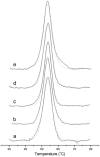Evidence that the heme regulatory motifs in heme oxygenase-2 serve as a thiol/disulfide redox switch regulating heme binding
- PMID: 17540772
- PMCID: PMC3957417
- DOI: 10.1074/jbc.M700664200
Evidence that the heme regulatory motifs in heme oxygenase-2 serve as a thiol/disulfide redox switch regulating heme binding
Abstract
Heme oxygenase (HO) catalyzes the O(2)- and NADPH-dependent conversion of heme to biliverdin, CO, and iron. The two forms of HO (HO-1 and HO-2) share similar physical properties but are differentially regulated and exhibit dissimilar physiological roles and tissue distributions. Unlike HO-1, HO-2 contains heme regulatory motifs (HRMs) (McCoubrey, W. K., Jr., Huang, T. J., and Maines, M. D. (1997) J. Biol. Chem. 272, 12568-12574). Here we describe UV-visible, EPR, and differential scanning calorimetry experiments on human HO-2 variants containing single, double, and triple mutations in the HRMs. Oxidized HO-2, which contains an intramolecular disulfide bond linking Cys(265) of HRM1 and Cys(282) of HRM2, binds heme tightly. Reduction of the disulfide bond increases the K(d) for ferric heme from 0.03 to 0.3 microm, which is much higher than the concentration of the free heme pool in cells. Although the HRMs markedly affect the K(d) for heme, they do not alter the k(cat) for heme degradation and do not bind additional hemes. Because HO-2 plays a key role in CO generation and heme homeostasis, reduction of the disulfide bond would be expected to increase intracellular free heme and decrease CO concentrations. Thus, we propose that the HRMs in HO-2 constitute a thiol/disulfide redox switch that regulates the myriad physiological functions of HO-2, including its involvement in the hypoxic response in the carotid body, which involves interactions with a Ca(2+)-activated potassium channel.
Figures









Similar articles
-
Heme regulatory motifs in heme oxygenase-2 form a thiol/disulfide redox switch that responds to the cellular redox state.J Biol Chem. 2009 Jul 31;284(31):20556-61. doi: 10.1074/jbc.M109.015651. Epub 2009 May 27. J Biol Chem. 2009. PMID: 19473966 Free PMC article.
-
Identification of a thiol/disulfide redox switch in the human BK channel that controls its affinity for heme and CO.J Biol Chem. 2010 Jun 25;285(26):20117-27. doi: 10.1074/jbc.M110.116483. Epub 2010 Apr 28. J Biol Chem. 2010. PMID: 20427280 Free PMC article.
-
Spectroscopic studies reveal that the heme regulatory motifs of heme oxygenase-2 are dynamically disordered and exhibit redox-dependent interaction with heme.Biochemistry. 2015 May 5;54(17):2693-708. doi: 10.1021/bi501489r. Epub 2015 Apr 22. Biochemistry. 2015. PMID: 25849895 Free PMC article.
-
The heme oxygenase dilemma in cellular homeostasis: new insights for the feedback regulation of heme catabolism.Tohoku J Exp Med. 2003 Aug;200(4):167-86. doi: 10.1620/tjem.200.167. Tohoku J Exp Med. 2003. PMID: 14580148 Review.
-
Redox Regulation of Heme Oxygenase-2 and the Transcription Factor, Rev-Erb, Through Heme Regulatory Motifs.Antioxid Redox Signal. 2018 Dec 20;29(18):1841-1857. doi: 10.1089/ars.2017.7368. Epub 2017 Nov 14. Antioxid Redox Signal. 2018. PMID: 28990415 Free PMC article. Review.
Cited by
-
Discovery of a heme-binding domain in a neuronal voltage-gated potassium channel.J Biol Chem. 2020 Sep 18;295(38):13277-13286. doi: 10.1074/jbc.RA120.014150. Epub 2020 Jul 28. J Biol Chem. 2020. PMID: 32723862 Free PMC article.
-
Thiol-disulfide redox dependence of heme binding and heme ligand switching in nuclear hormone receptor rev-erb{beta}.J Biol Chem. 2011 Feb 11;286(6):4392-403. doi: 10.1074/jbc.M110.193466. Epub 2010 Dec 1. J Biol Chem. 2011. PMID: 21123168 Free PMC article.
-
Comparison of the Mechanisms of Heme Hydroxylation by Heme Oxygenases-1 and -2: Kinetic and Cryoreduction Studies.Biochemistry. 2016 Jan 12;55(1):62-8. doi: 10.1021/acs.biochem.5b00943. Epub 2015 Dec 23. Biochemistry. 2016. PMID: 26652036 Free PMC article.
-
Hydrogen Sulfide Biochemistry and Interplay with Other Gaseous Mediators in Mammalian Physiology.Oxid Med Cell Longev. 2018 Jun 27;2018:6290931. doi: 10.1155/2018/6290931. eCollection 2018. Oxid Med Cell Longev. 2018. PMID: 30050658 Free PMC article. Review.
-
The yeast homolog of heme oxygenase-1 affords cellular antioxidant protection via the transcriptional regulation of known antioxidant genes.J Biol Chem. 2011 Jan 21;286(3):2205-14. doi: 10.1074/jbc.M110.187062. Epub 2010 Nov 16. J Biol Chem. 2011. PMID: 21081499 Free PMC article.
References
Publication types
MeSH terms
Substances
Grants and funding
LinkOut - more resources
Full Text Sources
Miscellaneous

